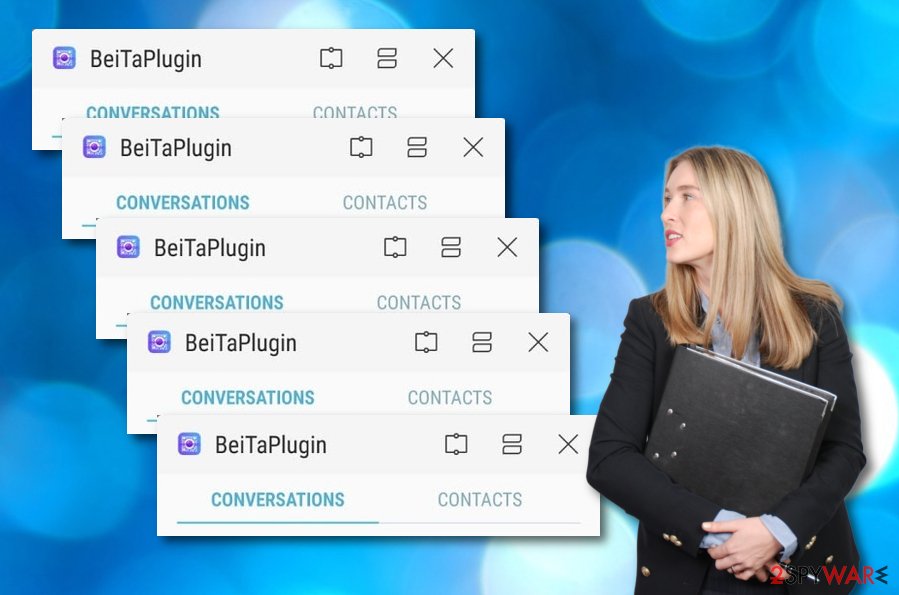BeiTaAd plug-in simple removal steps
BeiTaAd Removal Guide
What is BeiTaAd?
BeiTaAd – an advertising plug-in that has been injected into 238 Google Play Store apps

BeiTaAd is an adware plug-in that technology experts found inserted in 238 Google Play applications. Lookout researchers have recently released a report of this suspicious adware component that has been downloaded even for 440 million times before it got removed from the Play store.[1] BeiTaAd plugin infiltrates the device through bundles with applications that belong to Cootek. This organization is mostly known for releasing TouchPal[2] that also included the com.cootek.beita.plugin. Users who have been downloading various fitness and healthcare apps from this company are concerned about the intrusive display of advertisements that have shown up on their mobile phones after the installation of particular Play store applications.
BeiTaAd virus is most likely to show up not exactly after the installation of apps but after a 24 hour period only. Nevertheless, some users started experiencing intrusive pop-up ads only two weeks after the download. However, some good news is that the adware-based plug-in has already been removed from the Google Play Store.
| Name | BeiTaAd |
|---|---|
| Type | Adware-based plug-in |
| Also known as | com.cootek.beita.plugin |
| Located in | Google Play |
| Main bundle | Comes together with TouchPal mostly |
| First seen | In 2018 |
| Detection | FortectIntego can help you to find adware content in your device/machine |
Even though Cootek-developed applications are now safe to download, if you have installed them during the infectious period, BeiTaAd adware might still be lurking somewhere on your mobile phone or computer system. If the adware remains on your machine/device, its pop-up ads might bring you lots of unwanted consequences and activities.
BeiTaAd ads might start causing regular freezes or crashes on your device and its programs due to the huge number of advertisements that are being displayed on the screen. Furthermore, these pop-ups and pop-unders might start redirecting you to affiliate websites some of which might appear to be infected with malicious programs.
Our suggestion would be to remove BeiTaAd from your machine or device. If you are not sure if this adware has been bothering you lately, you can scan the entire computer system with FortectIntego and find out the truth. This software will perform a full system scan and inform you if something potentially unwanted is lurking on your machine.

If the program finds this adware, you should proceed with the BeiTaAd removal. You can do it with antimalware also or you can check the step-by-step guidelines that are provided at the end of this article. Furthermore, these instructions will help you clean web browsers such as Chrome, Firefox, Explorer, Edge, or Safari from suspicious content and changes.
For further information, BeiTaAd plug-in has been first released in 2018 and modified a few times since then. The past version of the app was renamed to icon-icomoon-gemini.renc and encrypted by using the AES cipher.[3] This type of technique has been used by bad actors for renaming executables to other types of files and distributing malware through them.[4]

Adware-based content distribution techniques on machines and devices
According to LesVirus.fr experts,[5] adware-related content can be injected in different types of sources which are commonly visited by a big number of users. For example, adware-based plug-ins can come injected into applications that are placed on official Internet stores or be bundled with other types of freeware/shareware.
The best way to protect yourself from secret adware installation is to opt for the right configuration mode. If you choose Quick or Recommended ones, you might experience unnoticed PUP infiltration. However, if you opt for Advanced or Custom configuration, you will have the opportunity of tracking all incoming objects by yourself.
Furthermore, you should take other precautionary measures also. In order to avoid ad-supported application and potentially unwanted content, you should:
- Keep a distance from unknown third-party protection. These websites lack protection and might include infectious hyperlinks of ads.
- Update programs regularly. If you keep outdated software on your machine or device, various hackers might decide to misuse such vulnerability.
- Install reliable antivirus protection. When you are choosing a reputable antimalware program for automatical computer protection, you need to make sure that it includes a big variety of protective features.
Terminate BeiTaAd plug-in from the system permanently
If you are likely to proceed with the BeiTaAd removal by yourself, you can check the below-displayed instructing steps that are provided for both Windows and Mac operating systems. Also, here you will find instructions for browser cleaning. This helps to refresh browser apps such as Chrome, Firefox, Explorer, Edge, and Safari.
However, if you do not want to waste your time and like effortless processes, we recommend choosing a reputable tool for adware detection. Also, by using antimalware you increase the chances of permanently removing the cyber threat from all infected locations. Note that you need to remove BeiTaAd virus from each directory that contains adware-based content, otherwise, the program might reboot itself soon.
You may remove virus damage with a help of FortectIntego. SpyHunter 5Combo Cleaner and Malwarebytes are recommended to detect potentially unwanted programs and viruses with all their files and registry entries that are related to them.
Getting rid of BeiTaAd. Follow these steps
Uninstall from Windows
Erase all adware traces from your Windows operating system with the help of these instructing steps:
Instructions for Windows 10/8 machines:
- Enter Control Panel into Windows search box and hit Enter or click on the search result.
- Under Programs, select Uninstall a program.

- From the list, find the entry of the suspicious program.
- Right-click on the application and select Uninstall.
- If User Account Control shows up, click Yes.
- Wait till uninstallation process is complete and click OK.

If you are Windows 7/XP user, proceed with the following instructions:
- Click on Windows Start > Control Panel located on the right pane (if you are Windows XP user, click on Add/Remove Programs).
- In Control Panel, select Programs > Uninstall a program.

- Pick the unwanted application by clicking on it once.
- At the top, click Uninstall/Change.
- In the confirmation prompt, pick Yes.
- Click OK once the removal process is finished.
Delete from macOS
Remove items from Applications folder:
- From the menu bar, select Go > Applications.
- In the Applications folder, look for all related entries.
- Click on the app and drag it to Trash (or right-click and pick Move to Trash)

To fully remove an unwanted app, you need to access Application Support, LaunchAgents, and LaunchDaemons folders and delete relevant files:
- Select Go > Go to Folder.
- Enter /Library/Application Support and click Go or press Enter.
- In the Application Support folder, look for any dubious entries and then delete them.
- Now enter /Library/LaunchAgents and /Library/LaunchDaemons folders the same way and terminate all the related .plist files.

Remove from Microsoft Edge
Delete unwanted extensions from MS Edge:
- Select Menu (three horizontal dots at the top-right of the browser window) and pick Extensions.
- From the list, pick the extension and click on the Gear icon.
- Click on Uninstall at the bottom.

Clear cookies and other browser data:
- Click on the Menu (three horizontal dots at the top-right of the browser window) and select Privacy & security.
- Under Clear browsing data, pick Choose what to clear.
- Select everything (apart from passwords, although you might want to include Media licenses as well, if applicable) and click on Clear.

Restore new tab and homepage settings:
- Click the menu icon and choose Settings.
- Then find On startup section.
- Click Disable if you found any suspicious domain.
Reset MS Edge if the above steps did not work:
- Press on Ctrl + Shift + Esc to open Task Manager.
- Click on More details arrow at the bottom of the window.
- Select Details tab.
- Now scroll down and locate every entry with Microsoft Edge name in it. Right-click on each of them and select End Task to stop MS Edge from running.

If this solution failed to help you, you need to use an advanced Edge reset method. Note that you need to backup your data before proceeding.
- Find the following folder on your computer: C:\\Users\\%username%\\AppData\\Local\\Packages\\Microsoft.MicrosoftEdge_8wekyb3d8bbwe.
- Press Ctrl + A on your keyboard to select all folders.
- Right-click on them and pick Delete

- Now right-click on the Start button and pick Windows PowerShell (Admin).
- When the new window opens, copy and paste the following command, and then press Enter:
Get-AppXPackage -AllUsers -Name Microsoft.MicrosoftEdge | Foreach {Add-AppxPackage -DisableDevelopmentMode -Register “$($_.InstallLocation)\\AppXManifest.xml” -Verbose

Instructions for Chromium-based Edge
Delete extensions from MS Edge (Chromium):
- Open Edge and click select Settings > Extensions.
- Delete unwanted extensions by clicking Remove.

Clear cache and site data:
- Click on Menu and go to Settings.
- Select Privacy, search and services.
- Under Clear browsing data, pick Choose what to clear.
- Under Time range, pick All time.
- Select Clear now.

Reset Chromium-based MS Edge:
- Click on Menu and select Settings.
- On the left side, pick Reset settings.
- Select Restore settings to their default values.
- Confirm with Reset.

Remove from Mozilla Firefox (FF)
Remove dangerous extensions:
- Open Mozilla Firefox browser and click on the Menu (three horizontal lines at the top-right of the window).
- Select Add-ons.
- In here, select unwanted plugin and click Remove.

Reset the homepage:
- Click three horizontal lines at the top right corner to open the menu.
- Choose Options.
- Under Home options, enter your preferred site that will open every time you newly open the Mozilla Firefox.
Clear cookies and site data:
- Click Menu and pick Settings.
- Go to Privacy & Security section.
- Scroll down to locate Cookies and Site Data.
- Click on Clear Data…
- Select Cookies and Site Data, as well as Cached Web Content and press Clear.

Reset Mozilla Firefox
If clearing the browser as explained above did not help, reset Mozilla Firefox:
- Open Mozilla Firefox browser and click the Menu.
- Go to Help and then choose Troubleshooting Information.

- Under Give Firefox a tune up section, click on Refresh Firefox…
- Once the pop-up shows up, confirm the action by pressing on Refresh Firefox.

Remove from Google Chrome
If some adware-based content has shown up on your Google Chrome web browser, you can get rid of it with the help of these guidelines:
Delete malicious extensions from Google Chrome:
- Open Google Chrome, click on the Menu (three vertical dots at the top-right corner) and select More tools > Extensions.
- In the newly opened window, you will see all the installed extensions. Uninstall all the suspicious plugins that might be related to the unwanted program by clicking Remove.

Clear cache and web data from Chrome:
- Click on Menu and pick Settings.
- Under Privacy and security, select Clear browsing data.
- Select Browsing history, Cookies and other site data, as well as Cached images and files.
- Click Clear data.

Change your homepage:
- Click menu and choose Settings.
- Look for a suspicious site in the On startup section.
- Click on Open a specific or set of pages and click on three dots to find the Remove option.
Reset Google Chrome:
If the previous methods did not help you, reset Google Chrome to eliminate all the unwanted components:
- Click on Menu and select Settings.
- In the Settings, scroll down and click Advanced.
- Scroll down and locate Reset and clean up section.
- Now click Restore settings to their original defaults.
- Confirm with Reset settings.

Delete from Safari
Remove unwanted extensions from Safari:
- Click Safari > Preferences…
- In the new window, pick Extensions.
- Select the unwanted extension and select Uninstall.

Clear cookies and other website data from Safari:
- Click Safari > Clear History…
- From the drop-down menu under Clear, pick all history.
- Confirm with Clear History.

Reset Safari if the above-mentioned steps did not help you:
- Click Safari > Preferences…
- Go to Advanced tab.
- Tick the Show Develop menu in menu bar.
- From the menu bar, click Develop, and then select Empty Caches.

After uninstalling this potentially unwanted program (PUP) and fixing each of your web browsers, we recommend you to scan your PC system with a reputable anti-spyware. This will help you to get rid of BeiTaAd registry traces and will also identify related parasites or possible malware infections on your computer. For that you can use our top-rated malware remover: FortectIntego, SpyHunter 5Combo Cleaner or Malwarebytes.
How to prevent from getting adware
Stream videos without limitations, no matter where you are
There are multiple parties that could find out almost anything about you by checking your online activity. While this is highly unlikely, advertisers and tech companies are constantly tracking you online. The first step to privacy should be a secure browser that focuses on tracker reduction to a minimum.
Even if you employ a secure browser, you will not be able to access websites that are restricted due to local government laws or other reasons. In other words, you may not be able to stream Disney+ or US-based Netflix in some countries. To bypass these restrictions, you can employ a powerful Private Internet Access VPN, which provides dedicated servers for torrenting and streaming, not slowing you down in the process.
Data backups are important – recover your lost files
Ransomware is one of the biggest threats to personal data. Once it is executed on a machine, it launches a sophisticated encryption algorithm that locks all your files, although it does not destroy them. The most common misconception is that anti-malware software can return files to their previous states. This is not true, however, and data remains locked after the malicious payload is deleted.
While regular data backups are the only secure method to recover your files after a ransomware attack, tools such as Data Recovery Pro can also be effective and restore at least some of your lost data.
- ^ Kristina Balaam. New adware "BeiTaAd" found hidden within popular applications in app store. Lookout. News blog.
- ^ TouchPal. Wikipedia. The free encyclopedia.
- ^ Advanced Encryption Standard (AES). Techopedia. Tech terms and definitions.
- ^ Dan Goodin. 238 Google Play apps with >440 million installs made phones nearly unusable. Arstechnica. Technology information source.
- ^ LesVirus.fr. LesVirus. Spyware and security news.























